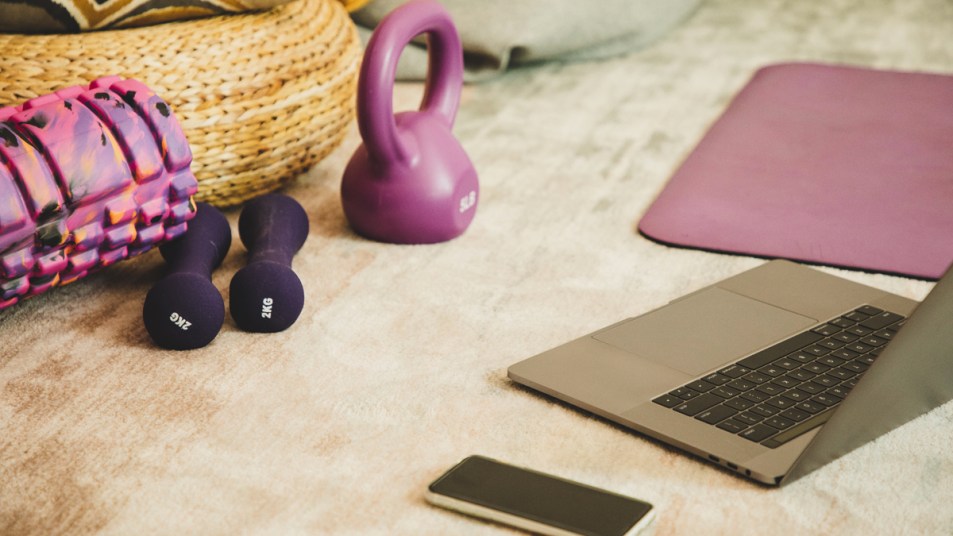How At-Home Strength Training Helped One Woman Finally Quit Smoking

Despite suffering from asthma and struggling to keep up with her grandkids, Kate Marlowe, 50, couldn’t quit smoking. Then she found at-home strength training made all the difference.
“You go ahead, I’ll catch up with you back at the house,” wheezed Kate. She braced her hands on her knees and gasped for air as she watched her family disappear up the wooded trail before turning and heading for home.
“My family loves outdoor activities like hiking, but I struggled to keep up because I had smoker’s-induced bronchospasms, or asthma as a result of smoking,” shares Kate. “On chilly fall days, I couldn’t even sit outside on the porch because the cold air was painful in my sensitive lungs. I knew it was because of my smoking, but I had such a hard time letting go.”
Stuck and Frustrated
“I discovered cigarettes as a rebellious teenager. At first, I only smoked in social scenarios on the weekends, but as I got older, cigarettes grew into my stress reliever. I teach third grade, and in Ohio, the third-graders have state testing. If they don’t pass, they don’t move on. As the person responsible for preparing them, I was under a lot of pressure. I had such a hard time calming my mind, but stopping for a smoke break provided a much-needed mental release. At the beginning of each school year, like clockwork, I would go from half a pack to a full pack of cigarettes each day.
“But my self-soothing strategy wasn’t without consequence. I developed smoker’s asthma and was dependent on three different medications, a rescue inhaler and a maintenance inhaler throughout most of the fall and winter. I would miss at least a week of school every year with severe bronchitis. What’s more, I couldn’t do a lot of the outdoor activities that my family loves because I struggled to breathe. I wanted to make memories with my grandchildren, but I physically couldn’t, and it broke my heart.
“I’d tried to quit smoking probably 10 times over the years. I’d tried various things that would work short-term, but I have a stomach disease, so I can’t use any of the common aids like patches or pills. And when the school year started, cigarettes were there, calling my name.
Freedom at Last
“One day, I was chatting with a coworker when she mentioned that she was a coach with Beachbody, an at-home strength training platform, and she encouraged me to try one of their exercise programs. I was hesitant because I was about to turn 50, and I didn’t think there was any way my body could do stuff like that anymore. I had chronic back and joint pain from a car accident I was in 25 years ago, and extra weight that made me nervous to try working out. Plus, between my young students and my seven grandchildren, I didn’t think I had the time or the energy. But my co-worker assured me that it would be worth it, so finally I signed up.
“The program they were promoting at the time was called Morning Meltdown 100, which incorporates strength training with cardio. The workouts were short, only 20 or 25 minutes, so it seemed doable. I decided to toss my cigarettes at the same time. In the days leading up to the program, I spent a lot of time thinking about how quitting would allow me to see my grandchildren grow up, and I worked on making some small healthy changes, like going for a walk when I craved a cigarette. The first workout was tough. I had never used weights before, and I struggled through the harder moves, but my coach encouraged me to stick with it.
“I started getting up early to work out before school, and completing the challenge in the morning made me feel like I could say ‘no’ to cigarettes all day.
“The first couple of weeks, I was dragging and dealing with the occasional desire to smoke, but then suddenly, my energy flipped and began to increase. I noticed I was breathing easier, and my cigarette cravings vanished.
“After a month, my joints no longer hurt, and I started losing weight too! I felt stronger and more energetic, which allowed me to be more engaged with my students and my grandchildren. (Click through to learn how quitting smoking can eliminate bad breath from the stomach.)
“Exercise not only made me feel physically stronger, it also helped me deal with my stress in a healthy way. I felt so good, I went on to try four other Beachbody programs and even became a coach myself (you can find me on Instagram at kate_marlowe_).
“My immune system has improved drastically. Last winter, I only took two sick days when I normally would have needed 10, and I’m down to just one allergy medication in the spring — no more inhalers! This summer, I’m enjoying outdoor fun with my family without worrying about keeping up or the urge to smoke. I haven’t felt this good since I was a teenager!”
How exercise makes it easier to kick the nicotine habit.
Exercise can be a powerful tool when you’re trying to quit smoking, says Sarah Linke, PhD, an associate professor at UC San Diego who studies smoking cessation. “Nicotine in cigarettes triggers the release of feel-good chemicals in the brain, and when you suddenly stop smoking, the brain experiences withdrawal,” she explains. “But exercise also releases these chemicals, making it an appealing and much healthier alternative to smoking.”
Developing a routine can help as well. “Healthy behaviors like exercise tend to make people feel empowered, which helps further the cycle of choosing healthy behaviors,” says Linke. The payoff: A study in Nicotine & Tobacco Research found that when smokers received counseling, nicotine patches and 12 weeks of resistance training, they were twice as likely to report not having smoked than those who only received counseling and patches.
To get the benefits, follow Kate Marlowe’s lead and exercise for 20 minutes up to six days a week. The type of workout is less important than doing it consistently. For a free workout like Kate’s that incorporates weights, try searching “basic strength training workout” on YouTube.
A version of this article originally appeared in our print magazine, First for Women.













